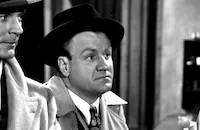Highway 301

Brief Synopsis
Cast & Crew
Andrew Stone
Steve Cochran
Virginia Grey
Gaby Andre
Edmon Ryan
Robert Webber
Film Details
Technical Specs

Synopsis
In Winston-Salem, North Carolina, the members of a gang known to the police as the Tri-State Gang because they have robbed banks in North Carolina, Virginia and Maryland, are spotted switching cars during a getaway. The farmer who saw them is able to identify the make of the second car and the first few letters of the license plate. The police have been unable to identify any of the gang members, who are George Legenza, William B. Phillips, Robert Mais, Herbie Brooks and Noyes. All have long police records, but received only light sentences. Now, the police hope the license plate will eventually lead them to the criminals, and a special group, headed by an investigator named Truscott, is put together to pursue them. That evening, the robbers celebrate with their wives and girl friends. Madeline Walton, Legenza's girl, is tired of life with a criminal, but when she begs Legenza to get out of the business, he brutally silences her. Phillips is newly married to Lee Fontaine, a French-Canadian woman who knows nothing of his real profession. The disgruntled Madeline drops broad hints to the truth, further angering Legenza. Realizing that she is in danger, Madeline tries to run away, but Legenza follows her and kills her. Lee blames herself for Madeline's death and begs Phillips to leave the gang. He promises that after they pull one more big job, he will return to Canada with her. Legenza, who has been tipped off to a shipment of two million dollars at the Richmond mint, kills one of the guards during the robbery, and the police set up roadblocks on the surrounding roads. The gang quickly discovers that the money, which was being returned to the mint for burning, has been cut into pieces, and after the gangsters pass the roadblock by hiding in a shipment of eggs, Legenza kills the tipster. When they return to the waiting women, Lee is extremely upset, causing Legenza to suspect that she might be a danger to the gang. Outside the apartment, a routine police check identifies the gang's car from the partial license number. They wait in the street for the gangsters to appear, and during the ensuing shootout, Phillips is killed. Legenza returns to the apartment, where Mais, his girl friend, Mary Simms, and Lee have remained. On Phillips' body, the police find several pictures of Lee. They investigate Phillips' acquaintances, and one of the policemen involved in the shootout identifies Legenza's photograph. Meanwhile, the remaining gangsters go into hiding. Realizing that Phillips' death leaves her vulnerable, Lee tries several times to escape, but is always stopped by Legenza. Finally, when he goes out to get something to eat, leaving Mais to guard her, Lee manages to escape from the apartment, but is spotted by the returning Legenza, who pursues and shoots her. The following day, Mary learns from a radio broadcast that Lee is not dead, but is in a coma. Legenza decides to finish the murder and sends Mary ahead to assess the situation. In the hospital, Mary pretends to be a reporter and, after she learns Lee's room number, telephones Legenza with the information. Her questions raise Truscott's suspicions, and she is arrested after her story breaks down under interrogation. There is a shootout when Mais and Legenza arrive at the hospital, and Mais is killed, but Legenza escapes. Later, the getaway car crashes, and again Legenza crawls away, but is killed by a train when he collapses on the tracks. The police conclude that the whole situation could have been avoided if the criminals had not been treated so leniently at the beginning of their careers.

Director

Andrew Stone
Cast

Steve Cochran

Virginia Grey
Gaby Andre

Edmon Ryan

Robert Webber

Wally Cassell
Aline Towne

Richard Egan

Edward Norris
Charles Mcavoy

John Alvin
Mary Alan Hokanson
Frank Meredith

Howard Mitchell
Robert Strong
Perc Launders
Paul Mcguire

Bob Carson
Ralph Montgomery
Jack Dawson
Charles Conrad
William J. Cartledge
Mervin Williams
Charles Marsh
Ed Peil Sr.
Jack Sterling
Charles Regan
Guy Kingsford
Luther Crockett

Bud Wolfe
Charles Sullivan
John Roy

Paul Maxey

Lyle Latell
Lewell Enge
Ilse Bay
Cathy Dart
Donna Gibson

Russ Conway
Bo Ling
George Magrill
Dick Bartell
Paula Hill
Bill White Jr.
Joanne Tree
Barbara Wooddell
John Mcguire
Sam Finn
Joan Wrae
Charles Sherlock
Ezelle Poule
John Morgan
Bert Davidson
Eileen Coghlan
Betty Finley
Crew

Film Details
Technical Specs

Articles
Highway 301 -
By Glenn Erickson

Highway 301 -
Quotes
Trivia
Notes
The film's working titles were The Tri-State Gang, Road Block, The One Million Dollar Bank Robbery, The Two Million Dollar Bank Robbery, and The Big Stickup. Andrew Stone's onscreen credit reads "Written and directed by." This film marked Gaby Andre's American film debut. The film is introduced by the governors of Maryland, William P. Lane; Virginia, John S. Battle; and North Carolina, W. Carr Scott, who attest to the factual basis of the film and emphasize that crime does not pay. The film uses a semi-documentary style. No credits appear until the end of the film and, as the Variety review notes, "Casting uses faces that are not too well established for most of the characters, sharpening documentary effect." Some scenes were shot on location at Union Station in Los Angeles.














